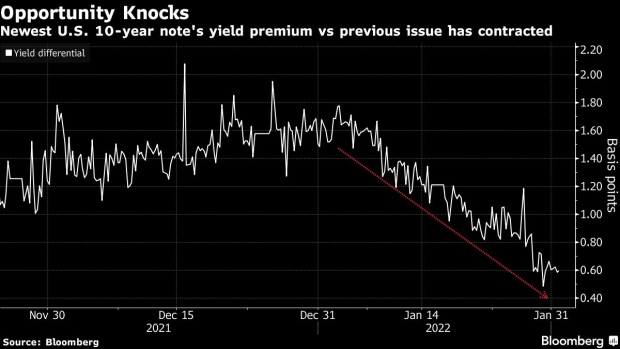Jan 31, 2022
Hedge-Fund Trade That Upended the Treasury Market Is Set to Return
, Bloomberg News

(Bloomberg) -- A money-making strategy formerly popular among hedge funds stands to make a comeback as the Federal Reserve plots to shrink its footprint in the U.S. Treasury market.
The strategy involves taking leveraged positions in Treasury notes and bonds in order to exploit price differences with the corresponding futures contracts. These so-called basis trades backfired during the March 2020 liquidity crisis, when the normal relationships between cash and futures broke down.
Since then, the Fed’s massive buying of Treasury notes and bonds has stripped the volatility out of the cash-futures relationship, while also bidding up the value of the older Treasuries normally used in basis trades.
With the Fed planning to wind down its buying of Treasuries by March and possibly to start shedding its holdings by attrition later this year, arbitrage opportunities may be set to return, Citigroup Inc. strategists Raghav Datla and Jason Williams said in a note late Friday.
The policy shift “should remove the dampening effect that Fed purchases had on the futures net-basis” and yield relationships between older and new Treasuries, they wrote. Also, financing rates for Treasuries should rise “and drive more dislocations in cash/futures markets.”
Since the start of the year, the yield differential between the newest 10-year note maturing in November 2031 and the second-newest, maturing three months earlier in August 2031, has shrunk. The older note’s yield is lower, but by a smaller margin than previously. That trend should continue as the increased supply of Treasuries in private hands leads to higher financing rates, the Citi strategists said.
As for the futures basis, it remains depressed for now despite strong investor demand for Treasury futures. The latest weekly data from the Commodity Futures Trading Commission show asset managers were net long almost 1.5 million five-year note contracts, near the highest level of the past two years.
©2022 Bloomberg L.P.


